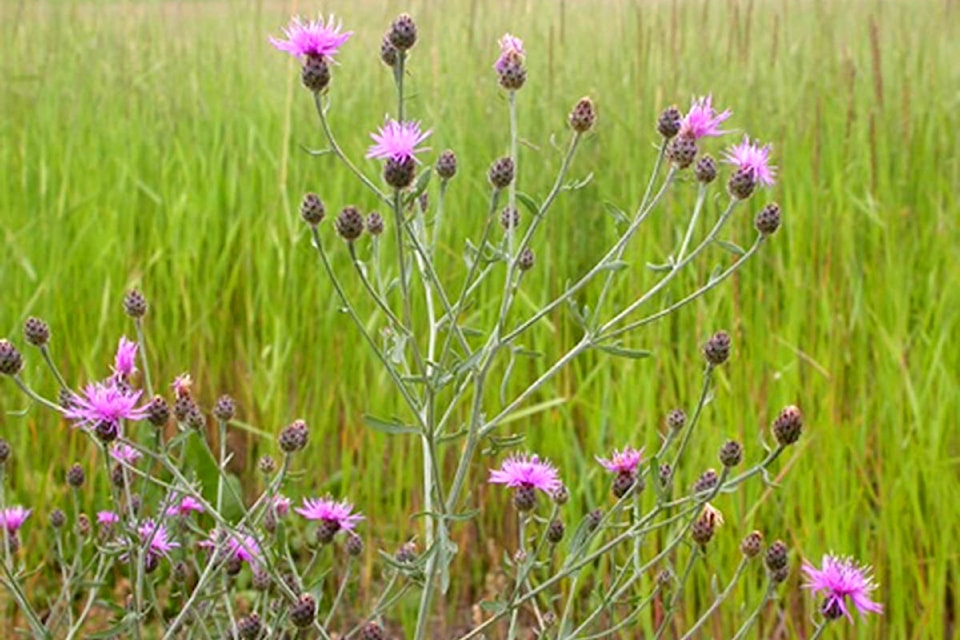Cariboo Regional District (CRD) stakeholders voted unanimously to proceed with enforcement action if a Cariboo ranching company fails to address a spreading invasive knapweed infestation on its properties.
In a weighted vote of all electoral areas, the City of Williams Lake and the District of Wells during the CRD board meeting Friday, Nov. 13, officials decided to proceed with a court-ordered injunction against Blue Goose Cattle Co. if the company does not meet its request.
“It’s been a reoccurring issue over the years, and we’ve been trying to work with Blue Goose to try to come to some type of collaborative or co-operative agreement for them to do their part and we’ve had mixed results,” said Emily Sonntag, invasive plant management co-ordinator with the CRD.
Blue Goose Cattle Co. (BGCC), who was not at the CRD meeting, is a certified organic cattle ranching operation responsible for the management and stewardship of over 250,000 acres of leased and deeded land within the Central and South Cariboo, and Chilcotin regions of the CRD.
Sonntag said collaboration and communication between the CRD and the company has deteriorated over the past eight years.
“The infestation is getting denser and larger, which has been noticed by a lot of residents in the area, as well as our program, so the problem is getting worse … I have not seen any evidence a concerted effort has taken place [on their behalf].”
Blue Goose Cattle Co. ranch manager Frank Schlueter, however, said contrary to the CRD’s report to the board Friday, the company has, in fact, been diligent and proactive dating back to 2015 and annually, thereafter, attempting to stop the knapweed spread. He added the knapweed spread is not simply a “Blue Goose issue.”
“Clearly, we have inherited this invasive plant issue from previous owners, as untreated and unmanaged knapweed on large sites has existed on the lands for decades,” Schlueter noted in an emailed response.
“[At that time in 2015] we hired a local (RPBio) biologist to introduce biological control in the form of predatory seed weevils and root weevils in order to get ahead of the issue.”
READ MORE: Controlling knapweed one plant at a time
A document titled ‘Spotted Knapweed Management Plan: Infestation Mapping, Biocontrol Presence Survey, and Management Options for the Blue Goose Cattle Company 105 Mile Operations” shows approximately 17.02 hectares, or 42.55 acres, of spotted knapweed in 2015 on the company’s 111 and 105 Mile, Walker Valley and Soda Lake properties.
The plan recommended biological control, prevention activities, monitoring activities and mechanical control activities such as moving road and trail-sides, however, Sonntag said aside from some biological controls and monitoring, evidence of the implementation of all other recommended control methods has been non-existent, and actions taken by the IPM co-ordinator to meet with BGCC to discuss plans and strategies have been ignored.
Schlueter said knapweed commonly spreads into grasslands beginning from roadsides and is brought into the area by vehicle traffic.
“Public roadways with weeds, which are left unchecked and untreated for decades, can cause large knapweed outbreaks,” he said.
“[This is] a larger community issue, brought about and started by neglect over early decades of lack of roadside weed management. These include Blue Goose, the CRD and potentially other funding sources for remediation.”
According the CRD report, inspection completed on July 15, 2020 in response to a complaint received on July 10 showed spotted knapweed presence on 14 separate properties owned by BGCC.
Sonntag said the 14 properties encompass approximately 15,427 acres in the 108, 105 and 11 Mile areas of the South Cariboo.
She estimates, based on the 2015 study and a conservative rate of spread of the infestation at 14 per cent, annually, the 17.02 hectares originally reported in 2015 may be approximately 32.7 hectares of 81.93 acres on the properties surveyed in the management plan.
Knapweed is identified as a serious threat to rangelands and forests of the western U.S. and Canada because it reduces forage production and quality and increases management costs and production losses for the agriculture industry.
The plant also reduces soil fertility and water infiltration into soil, while increasing surface water runoff and stream sedimentation. The CRD noted knapweed also reduces wildlife habitat and native biodiversity.
Following the board’s unanimous approval to proceed, the CRD will issue Blue Goose Cattle Co. a letter asking for voluntary compliance by the end of June of 2021 prior to plants setting seed and flowers. The letter would be issued this winter.
By the spring of 2021, properties will be inspected for evidence of compliance. Sonntag said if BGCC has failed to voluntarily comply the CRD will invite BGCC to a board meeting to justify why further enforcement actions are not warranted. Should the board decide further action is warranted, the CRD will proceed through a court-ordered injunction.
“It’s hard to say how large the infestation is now,” Sonntag said. “It could be a lot larger, and it is going to be extremely costly. I have ball parked it and, because it is an organic operation, if they are going to tackle it mechanically, costs are just under $6,000 a hectare … that’s going to be about $200,000 if it is around 80 hectares.
“I would expect they control the smaller infestations and start working into the main infestation. It’s going to be a multi-year process.”
greg.sabatino@wltribune.com
Like us on Facebook and follow us on Twitter
